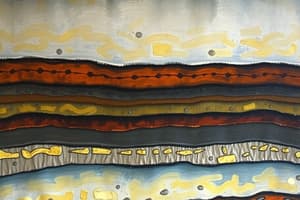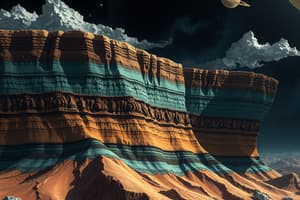Podcast
Questions and Answers
Which elements are primarily found in the mantle?
Which elements are primarily found in the mantle?
- Calcium, Sodium, Potassium, Carbon
- Titanium, Lithium, Nickel, Manganese
- Copper, Zinc, Lead, Aluminum
- Iron, Magnesium, Silicon, Oxygen (correct)
Which of the following combinations include at least three elements found in the mantle?
Which of the following combinations include at least three elements found in the mantle?
- Iron, Magnesium, Carbon
- Iron, Magnesium, Silicon, Oxygen (correct)
- Silicon, Oxygen, Lithium
- Sodium, Titanium, Iron
What is a primary characteristic of the mantle's composition?
What is a primary characteristic of the mantle's composition?
- It consists largely of heavier elements like Iron and Magnesium. (correct)
- It is mainly composed of light gases.
- It primarily consists of sedimentary rocks.
- It contains a significant amount of Aluminum.
Which of the following elements is NOT commonly found in the mantle?
Which of the following elements is NOT commonly found in the mantle?
Which elements are most commonly associated with the Earth's mantle layer?
Which elements are most commonly associated with the Earth's mantle layer?
What is the main characteristic of the oceanic crust compared to the continental crust?
What is the main characteristic of the oceanic crust compared to the continental crust?
Which of the following elements is NOT primarily found in the Earth's crust?
Which of the following elements is NOT primarily found in the Earth's crust?
What phase is the material in the outer core of the Earth?
What phase is the material in the outer core of the Earth?
What is the approximate thickness of the mantle compared to the entire Earth?
What is the approximate thickness of the mantle compared to the entire Earth?
Which layer of the Earth reaches temperatures of about 5000°C and is solid due to high pressure?
Which layer of the Earth reaches temperatures of about 5000°C and is solid due to high pressure?
What feature of the upper mantle is significant?
What feature of the upper mantle is significant?
Which layer of the mantle lies just above the Asthenosphere?
Which layer of the mantle lies just above the Asthenosphere?
What is a primary characteristic of the Asthenosphere?
What is a primary characteristic of the Asthenosphere?
Which term best describes the zone in the upper mantle that allows for tectonic plate movement?
Which term best describes the zone in the upper mantle that allows for tectonic plate movement?
How does the Asthenosphere affect tectonic activities?
How does the Asthenosphere affect tectonic activities?
What are the primary materials that constitute the inner core?
What are the primary materials that constitute the inner core?
Which combination of elements is found in the inner core?
Which combination of elements is found in the inner core?
Which of the following statements about the inner core is true?
Which of the following statements about the inner core is true?
What can be inferred about the composition of the inner core?
What can be inferred about the composition of the inner core?
Among the following, which elements predominantly make up the inner core?
Among the following, which elements predominantly make up the inner core?
Which element ranks as the most abundant in the Earth's crust?
Which element ranks as the most abundant in the Earth's crust?
What role does oxygen play in the composition of the Earth's crust?
What role does oxygen play in the composition of the Earth's crust?
Which of the following statements about the Earth's crust is true?
Which of the following statements about the Earth's crust is true?
Why is understanding the composition of the Earth's crust important?
Why is understanding the composition of the Earth's crust important?
Which statement regarding the Earth’s crust is incorrect?
Which statement regarding the Earth’s crust is incorrect?
What is the phase of the inner core?
What is the phase of the inner core?
How does the thickness of the outer core compare to the inner core?
How does the thickness of the outer core compare to the inner core?
What is the approximate thickness range of the Earth's crust beneath the oceans?
What is the approximate thickness range of the Earth's crust beneath the oceans?
Which of the following correctly describes the outer core?
Which of the following correctly describes the outer core?
What causes earthquakes according to the description of the Earth's crust?
What causes earthquakes according to the description of the Earth's crust?
Which statement about the inner and outer core is true?
Which statement about the inner and outer core is true?
Which statement correctly describes the Earth's crust?
Which statement correctly describes the Earth's crust?
What is the main composition of the Earth's crust?
What is the main composition of the Earth's crust?
Which of the following is a characteristic of the outer core?
Which of the following is a characteristic of the outer core?
How does the thickness of the Earth's crust vary beneath land compared to beneath oceans?
How does the thickness of the Earth's crust vary beneath land compared to beneath oceans?
What is the Earth's outermost layer called?
What is the Earth's outermost layer called?
Which layer of the Earth makes up the majority of its volume and mass?
Which layer of the Earth makes up the majority of its volume and mass?
What are the two subdivisions of the Earth's core?
What are the two subdivisions of the Earth's core?
Which statement about the Earth's layers is true?
Which statement about the Earth's layers is true?
Which layer lies directly beneath the Earth's crust?
Which layer lies directly beneath the Earth's crust?
What layers of the Earth does the lithosphere consist of?
What layers of the Earth does the lithosphere consist of?
Which of the following best describes the physical state of rocks in the lithosphere?
Which of the following best describes the physical state of rocks in the lithosphere?
What is the maximum depth of the lithosphere?
What is the maximum depth of the lithosphere?
Which of the following statements about the lithosphere is false?
Which of the following statements about the lithosphere is false?
How is the lithosphere primarily represented in a diagram of the Earth's layers?
How is the lithosphere primarily represented in a diagram of the Earth's layers?
What is the primary function of the athenosphere in relation to tectonic plates?
What is the primary function of the athenosphere in relation to tectonic plates?
How does the composition of the athenosphere compare to that of the lithosphere?
How does the composition of the athenosphere compare to that of the lithosphere?
What characteristic of the athenosphere allows it to flow?
What characteristic of the athenosphere allows it to flow?
Which statement accurately describes the position of the athenosphere in relation to other layers of the Earth?
Which statement accurately describes the position of the athenosphere in relation to other layers of the Earth?
What visual characteristic can help identify the athenosphere in a cross-section of the Earth?
What visual characteristic can help identify the athenosphere in a cross-section of the Earth?
Flashcards are hidden until you start studying
Study Notes
Earth's Layers
- The Earth's crust is the outermost layer, averaging 40 kilometers in thickness, primarily made of oxygen and silicon.
- Continental crust varies from 35 to 40 kilometers thick, composed mainly of less dense granite rock, including aluminum, magnesium, calcium, iron, sodium, titanium, and hydrogen.
- Oceanic crust is thinner, ranging from 7 to 10 kilometers, composed of dense basalt rock, making it heavier than continental crust.
- The mantle, extending 2900 kilometers, constitutes about 50% of Earth's volume and 68% of its mass, consisting mainly of iron, magnesium, silicon, and oxygen. The upper part is partially molten, known as the Asthenosphere.
- The outer core, liquid at 2200 kilometers thick, generates Earth's magnetic field by movement around the inner core.
- The inner core, with a thickness of 1278 kilometers, is solid due to immense pressure despite temperatures reaching about 5000°C.
Key Composition Facts
- The inner core is primarily made up of iron and nickel.
- The most abundant element in Earth's crust is oxygen.
Asthenosphere
- The Asthenosphere, located below the lithosphere in the upper mantle, consists of molten rock that flows like hot asphalt.
- This layer is crucial for tectonic plate movement, influencing geological activities like earthquakes.
Lithosphere
- The lithosphere encompasses the uppermost part of the mantle and the crust, with a thickness of approximately 100 kilometers.
- It is characterized by hard, brittle rock, forming a rigid layer that interacts with the Asthenosphere beneath it.
Core Differences
- The outer core is thicker and in a liquid state, while the inner core is solid, despite its higher temperatures.
Studying That Suits You
Use AI to generate personalized quizzes and flashcards to suit your learning preferences.




